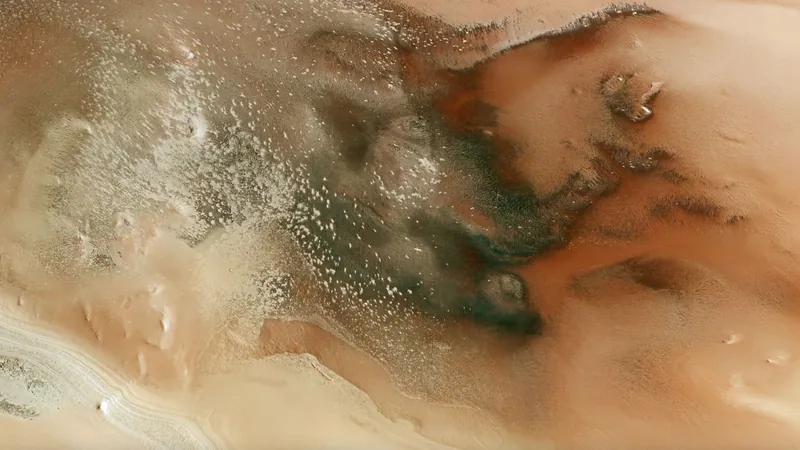
Mars Reveals Its Secrets: Cryptic Terrain Spotted Near Southern Ice Caps!
2024-10-14
Author: Lok
Exciting New Images from Mars Orbiters
Exciting new images from two European Mars orbiters have unveiled a treasure trove of mysterious features near the icy south pole of Mars. As spring unfolds in this frigid region of the Red Planet, these peculiar surface formations are coming to light, sparking curiosity and speculation among scientists and space enthusiasts alike.
ESA's Mars Express Mission
The European Space Agency's (ESA) Mars Express mission, on April 2, 2024, captured stunning images of the Australe Scopuli region using its High Resolution Stereo Camera (HRSC). These newly released photos showcase the planet's seasonal polar caps, which are primarily composed of carbon dioxide ice mixed with some water ice. As Martian spring progresses, part of this ice sublimates, transitioning directly from solid to gas and releasing significant quantities of vapor into the thin atmosphere. ESA officials explained that this event is crucial for understanding seasonal changes on Mars.
The Cycle of Freeze and Thaw
As autumn rolls in, the chilly temperatures cause the vapor to condense, forming extensive, thick polar caps in preparation for the looming winter season. This cycle of freeze and thaw leads to the creation of intriguing surface features, many of which are dubbed 'cryptic terrain' due to their surprisingly dark appearance compared to the surrounding icy landscapes. These mysterious formations caught the attention of ESA researchers, who noted their unique characteristics.
Contrasting Surface Features
The photos highlight a striking contrast between thick, layered deposits embedded with dust on one side and smooth, pristine layers on the other. In the center, the darker terrain reveals intricate polygon patterns with icy edges, believed to have formed over time due to the repeated freeze-thaw cycles, potentially spanning decades or even centuries.
ESA's Trace Gas Orbiter Contribution
Adding to the mystery, ESA's Trace Gas Orbiter (TGO) has also been studying these enigmatic landforms. Its high-resolution images from a different area in the southern hemisphere provide an up-close look at the frost-fringed polygons, fueling further interest in these Martian formations.
Unique Icy Features and Climate Dynamics
The released imagery also showcases fan-shaped deposits ranging from tens to hundreds of meters, along with jets of trapped vapor breaking through the melting ice layer, carrying dark dust from below. When this dark material settles, it absorbs solar energy more efficiently than ice, accelerating the melting process and causing the dark dust to sink deeper into the ice, leading to even more fascinating interactions between surface materials.
The Quest for Understanding Mars
The ongoing study of these unique icy features is essential for uncovering the historical climate dynamics of Mars. Through these astonishing images, researchers believe they can gain insights into the planet's past and perhaps its potential for supporting life. As Mars continues to surprise scientists, the quest for understanding its complex atmospheric and geological interactions remains a thrilling frontier in space exploration.
Stay Tuned for More Discoveries!
Stay tuned for more captivating discoveries from the Red Planet!


 Brasil (PT)
Brasil (PT)
 Canada (EN)
Canada (EN)
 Chile (ES)
Chile (ES)
 España (ES)
España (ES)
 France (FR)
France (FR)
 Hong Kong (EN)
Hong Kong (EN)
 Italia (IT)
Italia (IT)
 日本 (JA)
日本 (JA)
 Magyarország (HU)
Magyarország (HU)
 Norge (NO)
Norge (NO)
 Polska (PL)
Polska (PL)
 Schweiz (DE)
Schweiz (DE)
 Singapore (EN)
Singapore (EN)
 Sverige (SV)
Sverige (SV)
 Suomi (FI)
Suomi (FI)
 Türkiye (TR)
Türkiye (TR)